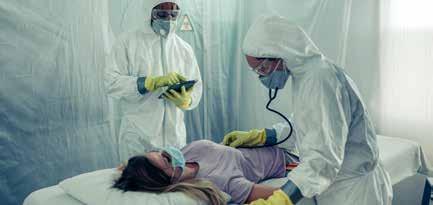
5 minute read
Stay With Us to Make Your Bed Connected
Jitka Stranska, Managing Director LINET MEA
Healthcare has undergone rapid development in recent decades. The development of science, technology, and techniques brings immense benefits. We can take care of patients who would not have a chance to survive in the past because new methods, technologies, and devices are available to doctors and nurses. On the other hand, this entails extraordinary demands - healthcare professionals have to cover and consume a large amount of information and work with technically advanced and complex devices. All of this is coupled with an extreme increase in the administrative agenda.
Advertisement
In addition, despite all the progress, hospital-acquired complications have not disappeared. Falls remain one of the most serious risks, they cause health complications for patients, an increase in the work of health professionals, and raise the cost of hospitalization. The overload of health professionals is always a real threat that limits the functioning of health systems, not only during a pandemic.
LINET's SafetyMonitor system provides benefits for all parties. The patient is safer because the risk of falls and injuries is reduced. The hospital staff, including nurses and doctors have online information about their patients clearly displayed on a monitor, tablet, DIGITIZATION AND INTEGRATION OF INFORMATION IN THE ONLINE ENVIRONMENT CAN ELIMINATE THESE PROBLEMS. WE, AT LINET, HAVE JOINED THIS TREND. FOR INTEGRATION WITH THE DIGITAL ENVIRONMENT, OUR BEDS ARE EQUIPPED WITH SENSORS THAT CAN MONITOR SAFETY PARAMETERS, THE PRESENCE OF THE PATIENT ON THE BED, AND EVEN THE POSITION OF THE BED ITSELF. EVERYTHING IS IMMEDIATELY REPORTED TO THE STAFF, INCLUDING ALERTS THAT WARN OF RISKY SITUATIONS. RECORDS ARE THEN EVALUATED AND EXPORTED DIRECTLY TO HOSPITAL SYSTEMS.
or mobile phone. This increases their efficiency because they can schedule and organize their time better without becoming overloaded. Data analysis and evaluations are essential for good management and service which is why SafetyMonitor uses the HL7 v2 standard for transmitting messages. It can be connected to any 3rd party system (nurse call, HIS, etc.) compatible with HL7 v2. From a managerial point of view, financial benefits are also key. According to the meth-

odology evaluating the consequences of falls in hospitals, it was calculated that by installing SafetyMonitor on 100 beds, the hospital can save more than $ 100,000.
The big advantage is the simplicity, clarity, and intuitiveness of the whole system. Based on several long-term field tests, it was confirmed that the SafetyMonitor application is considered by users, ie. nurses as useful, trustworthy, user-friendly, and most importantly functional. 65% of nurses claim SafetyMonitor's bed control is user-friendly and helped increase overall patient safety.
I am glad that we have a simple and functional tool that has positive feedback from users. It is a confirmation of the importance and usefulness of smart technologies, which is an area that we intensively focus on as an innovative company. Stay with us to make your bed connected.

Covid-19: Protecting Staff, Protecting Patients
By Ben Kanter, MD, FCCP, Chief Medical Information Officer, Vocera
Clinicians and nurses contend with infectious diseases every day. The COVID-19 pandemic is highlighting this stressful aspect of care, partly because it’s highly contagious, and also because it’s creating unprecedented demand to protect hospital staff coupled with the need to optimize patient flow.
Caregivers Shouldn’t Risk Contamination for Communication
Without effective communication, patients cannot be moved through a hospital. And, yet, with a highly infectious virus, the simple act of communicating using conventional tools puts caregivers at risk. If you are a nurse wearing personal protective equipment (PPE) while treating a patient behind closed doors and must urgently contact someone for assistance, you’re faced with a problem. You may have to interrupt caring for your patient to communicate using the intercom. If there is no intercom, you will need to leave the patient’s bedside and remove your PPE, risking self-contamination and delaying your ability to have the necessary discussion. The less you need to temporarily remove PPE, the safer you are. Additionally, by not removing PPE to communicate, you will preserve your valuable, but limited, supply of protective gear. Here is where Vocera technology can provide you with an ideal solution: our wearable, hands-free devices.
Communication technology is an integral component of PPE
Worn under PPE, our classic Vocera Badge and the new Smartbadge give you and your staff access to a clear, secure, hands-free communication channel that will keep everyone safer - whether they are working in a triage tent, ICU, an isolation room, or elsewhere in the hospital. And it enables care teams to provide safer, high-quality patient care. Using a voice interface to connect care team members - either by name, role, location or group (“Call Robert Jones”, “Call room 101 nurses”, “Call lab”, or “Broadcast to rapid response team”) - eliminates the need to remove PPE or touch a device, and allows for unfettered, efficient communication. WORN UNDER PPE, OUR CLASSIC VOCERA BADGE AND THE NEW SMARTBADGE GIVE YOU & YOUR STAFF ACCESS TO A CLEAR, SECURE, HANDS-FREE COMMUNICATION CHANNEL THAT WILL KEEP EVERYONE SAFER.
Optimizing Throughput and Capacity
Effective communication is essential for optimizing throughput and capacity, which are key to managing patient surges anticipated during a pandemic of this scale. A hospital must be able to move patients through the continuum of care quickly and safely. As an example: whether a patient tests positive or negative for COVID-19, it’s vital that care teams are notified immediately. Patients who test negative can be moved out of isolation rooms, freeing them up - and potentially other resources - for other patients.
When a hospital’s communication and clinical systems are integrated, processes can be automated, reducing the risk of communication delays or errors and shortening the time to react. Automatic alerts sent when certain triggers occur means caregivers don’t need to constantly monitor the EHR for status updates. Critical lab results, as an example, can be sent directly to the right care team member in real-time. Patient care is expedited, throughput is improved, and clinicians have less to remember, alleviating cognitive burden. Deploying notifications intelligently reduces the toil and stress on care teams.
In this challenging time, it has never been more critical to keep staff and patients safe and in touch with each other. By taking advantage of systems integrations, intelligent workflows, and hands-free communication devices, hospitals can advance their protection efforts now.
Vocera is here to take care of you as you continue to take care of your staff and patients. Visit our COVID-19 resource page for more helpful resources and information: https://www.vocera.com/our-mission/covid-19











